Westminster Abbey, Henry VII Lady Chapel + Visiting Guide
20 min readWestminster Abbey, and the Henry VII Lady Chapel are not just London’s top attractions, but also a monumental piece of British history and culture. Westminster Abbey is particularly famous for...
The post Westminster Abbey, Henry VII Lady Chapel + Visiting Guide appeared first on Timeless Travel Steps.
Westminster Abbey, and the Henry VII Lady Chapel are not just London’s top attractions, but also a monumental piece of British history and culture. Westminster Abbey is particularly famous for its rich history and impeccable Gothic architecture, which makes it worth visiting. Founded in 960 AD, Westminster Abbey is a Royal Peculiar that falls directly under the authority of the monarch. As a UNESCO World Heritage Site, it stands as one of the most significant landmarks in England.
For over a thousand years, this magnificent Gothic church has stood witness to some of the most significant events in the nation’s history, from royal coronations of William the Conqueror in 1066, and the wedding of Prince William to Catherine Middleton in 2011, to the burials of 18 monarchs and over 3,300 renowned scientists, writers, and prominent figures.
Although I had visited Westminster Abbey and Lady Chapel a few times before, I recently visited again because I was fascinated to learn more about the Queen’s Diamond Jubilee Galleries, which I hadn’t visited. This visit allowed me to see the Abbey from a fresh perspective, deepening my appreciation for areas like the Choir Screen, Poet’s Corner and especially the Lady Chapel which is often not written about.
In this post, I’ll provide you with all the essential tips you need to make the most of your visit. You’ll find practical information on ticket prices and the best times to visit, ensuring you can plan your trip efficiently and avoid the crowds. I will guide you through the must-see highlights within the Abbey, with a special focus on the Henry VII Lady Chapel, renowned for its stunning beauty and historical significance.
Whether it’s your first time or a return visit, this guide will help you uncover the rich tapestry of history and culture woven into the very fabric of this extraordinary place.
Timeless Travel Steps is supported by our readers. If you purchase through an affiliate link on my site, at no cost to you, I may earn a commission from qualifying purchases. Please read our Disclosure for further information.
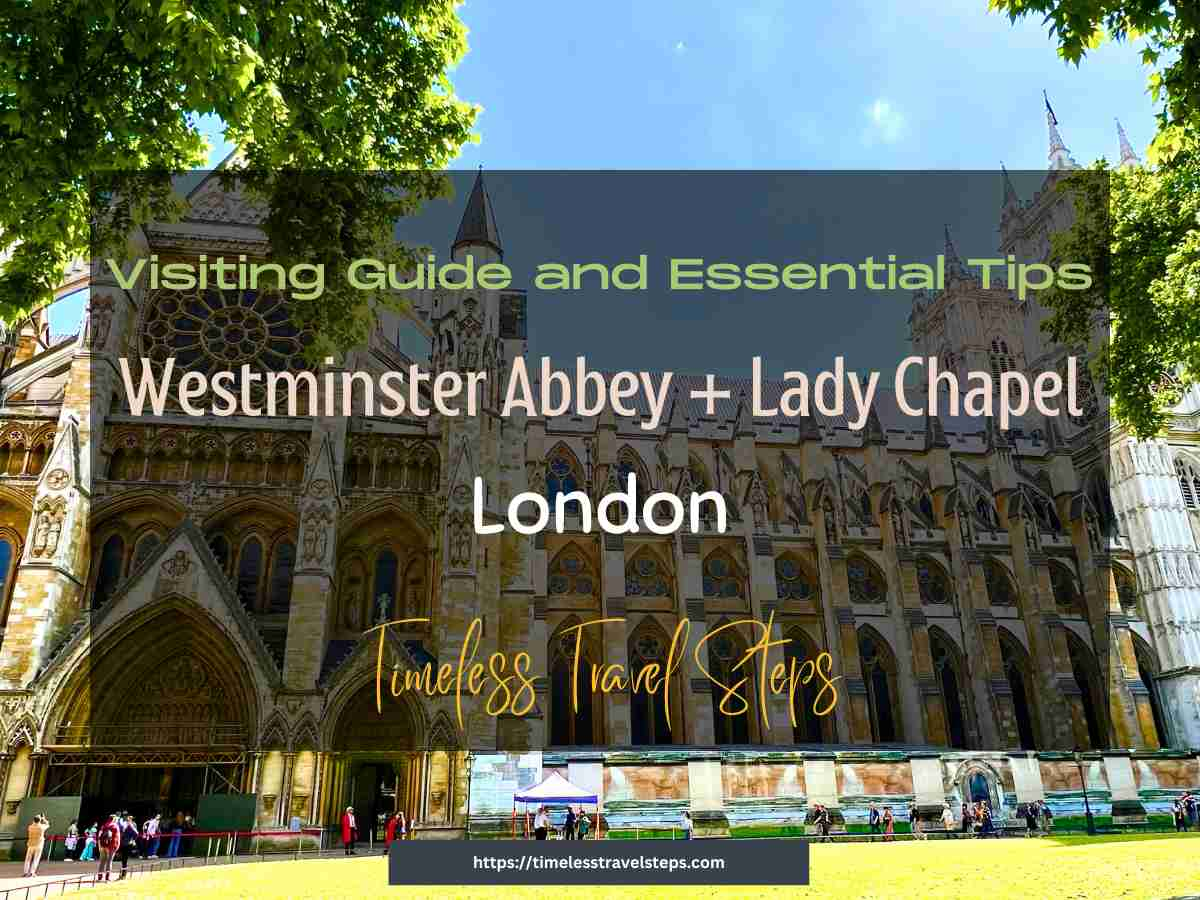
Westminster Abbey, London
Westminster Abbey dates back to 960 AD, when a Benedictine monastery was established on the site by Saint Dunstan and King Edgar the Peaceful. This early foundation marks the beginning of continuous religious activity at Westminster.
King Edward the Confessor significantly rebuilt and expanded the Abbey, beginning around 1045. He constructed a grand Romanesque church dedicated to St. Peter, which was consecrated in 1065, shortly before his death. This rebuilding laid the groundwork for the Abbey’s development into a major religious center, ultimately becoming the site of royal coronations and burials.
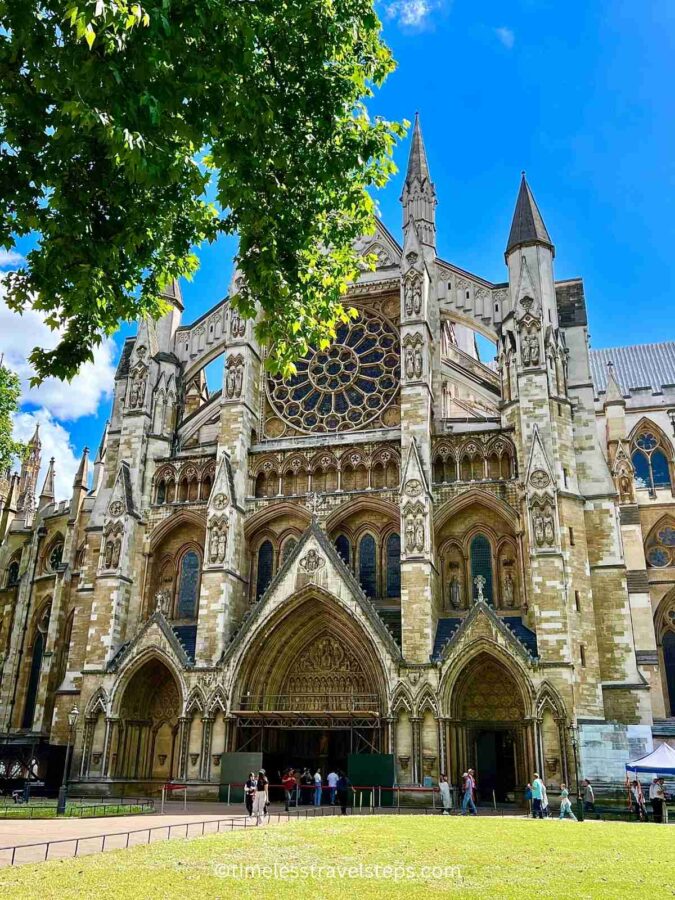
Essential Tips for Visiting Westminster Abbey and Lady Chapel
Hours, Ticket Information, and Guided Tour
Hours: Westminster Abbey opens at 9:30 am from Monday to Friday, with the last entry at 3:30 pm and at 9:00 am on Saturdays, with the last entry at 3:00 pm.
Ticket Information and Online Purchases: To visit Westminster Abbey, you’ll need to purchase a ticket. Tickets are available for adults, children (6-17), and are free for children 5 and under. For those who are 65+ and for students, you pay a reduced price. The Queen’s Diamond Jubilee Galleries require an additional £5 (free for children 17 and under). Buy tickets online to skip the ticket lines and get quicker entry or purchase a London Pass.
Even if you have pre-booked tickets online, expect a small queue due to high demand.
Opt for a guided tour led by the Abbey’s vergers. This is an informative tour, that takes you to areas not usually open to visitors and information not usually found in any guide books. The duration is 90 minutes, and you can only book this on the day of your visit.
Always check the official website for any changes in opening hours due to special services or events.
When is the Best Time to Visit Westminster Abbey and Lady Chapel
The Best Times to Visit Westminster Abbey and Lady Chapel to avoid crowds varies from first thing in the morning and after lunch. Aim to arrive at opening time before the crowd begins to arrive at 10:00 am onwards. Alternatively, visit around 2:30 pm after the peak hours of 11 am to 2 pm. Avoid school holidays, if at all possible, as this is a peak season for tourists.
How Long do you need at Westminster Abbey and Henry VII Lady Chapel
If you’re wondering how much time you need at Westminster Abbey, I’d suggest that realistically, you should set aside at least 2 to 3.5 hours. This includes a visit to the Queen’s Diamond Jubilee Galleries, which can take between 45 minutes to an hour. You certainly need to add extra time if visiting during peak times. I spent about 4+ hours and thoroughly enjoyed my exploration even though it was really busy on the day I visited.
Dress Code, Bag Policy and Photography at Westminster Abbey
Dress Code: As in any place of worship, Westminster Abbey has a dress code also. Dress conservatively, with shoulders covered, no mini skirts or short short shorts. Remove hats inside the Abbey.
Westminster Abbey’s Bag Policy states that for safety and comfort, large backpacks and suitcases are not permitted. There are no storage facilities, so plan to leave these items elsewhere.
Photography is restricted inside the Abbey. No photography at all is allowed in the Queen’s Diamond Jubilee Galleries
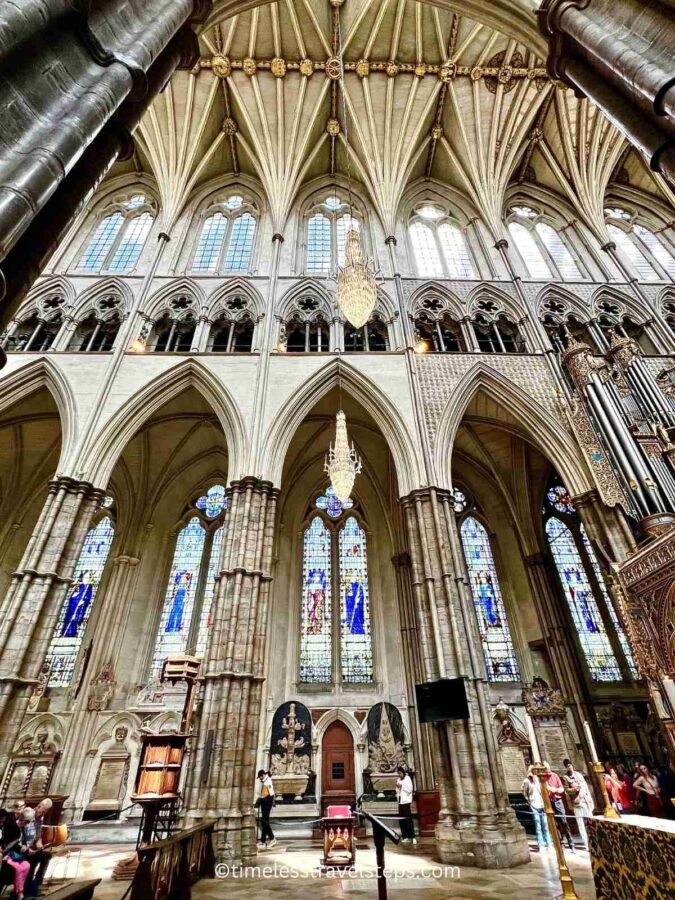
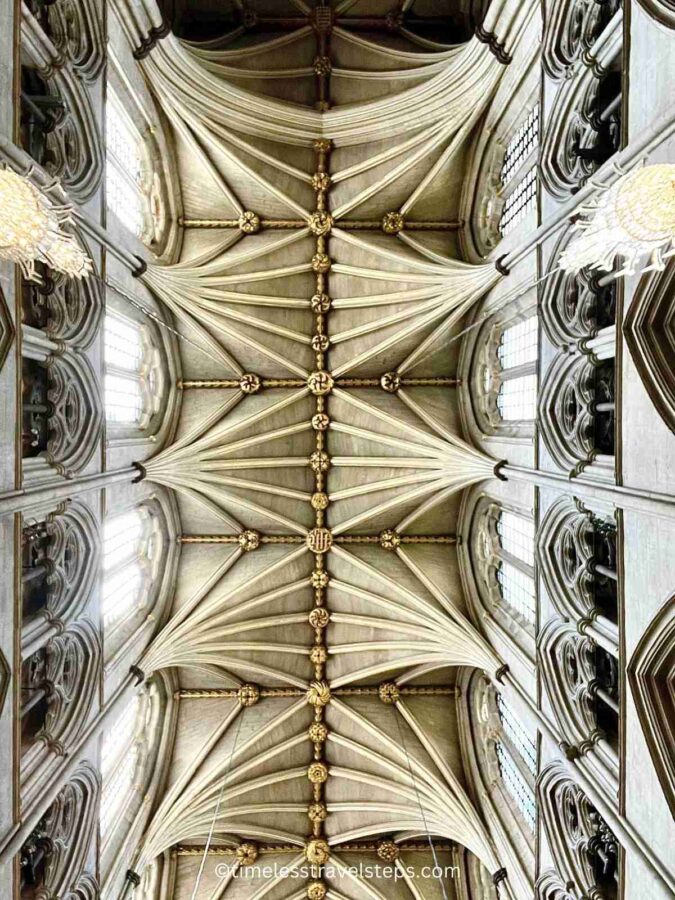
PRO TIP: If you choose to explore Westminster Abbey on your own, an established walking route is available to guide you. Collect an audio guide in your chosen language at the main entry point. The audio guide covers all the key highlights, with each highlight numbered along the route. except for the exterior of the church. There’s signage and helpful guides throughout the Abbey to help direct you along the path.
Westminster Abbey, Henry VII Lady Chapel Highlights: What Not to Miss at Westminster Abbey
Upon arriving at Westminster Abbey, head towards the Great North Door entrance, where you’ll pass through security checks before entering the Abbey. Inside, Westminster Abbey is a treasure trove of history, architecture, and culture, offering you a journey through over a thousand years of British heritage. Here’s a walkthrough of the must-see highlights:
The Queen’s Window
Upon entering through the Great North Door, you’ll be awestruck by the extraordinary architecture inside the Abbey. Start by admiring the stunning Queen’s Window, a recent addition in 2018, made with traditional hand-blowing technique. Designed by artist David Hockney, the window features vibrant colours and modern designs, portraying a vivid rural landscape that contrasts beautifully with the Gothic architecture.
The Grave of the Unknown Warrior
As you proceed down the aisle, you will come across the Grave of the Unknown Warrior, whose body was brought from France to be buried here on 11th November 1920. The grave, containing soil from France, is covered by a slab of black Belgian marble sourced from a quarry near Namur. Surrounded by poppies, this poignant memorial remains untouched by any visitor’s foot and honours the countless soldiers who lost their lives in World War I.
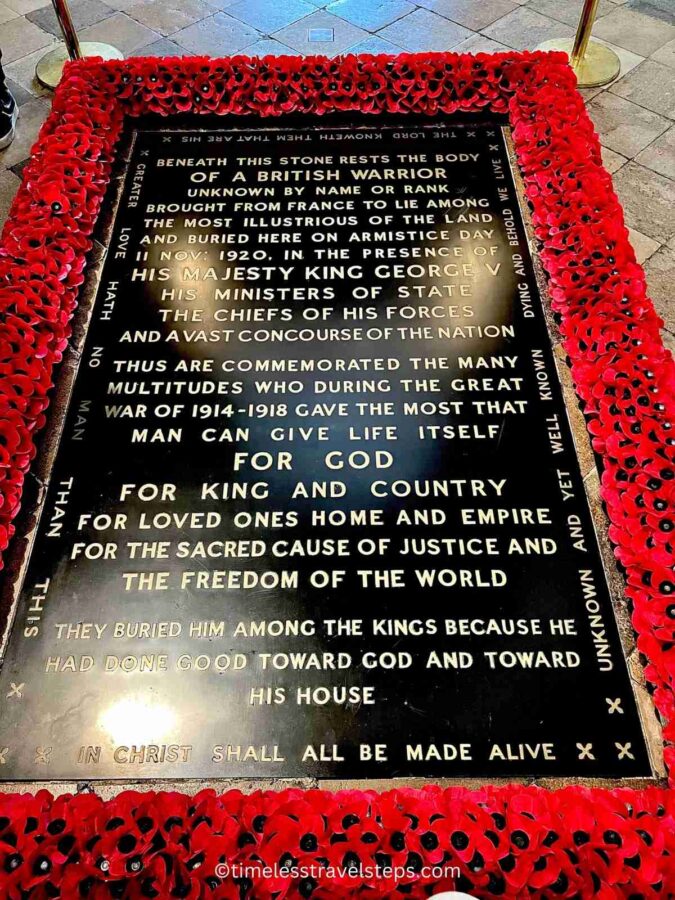
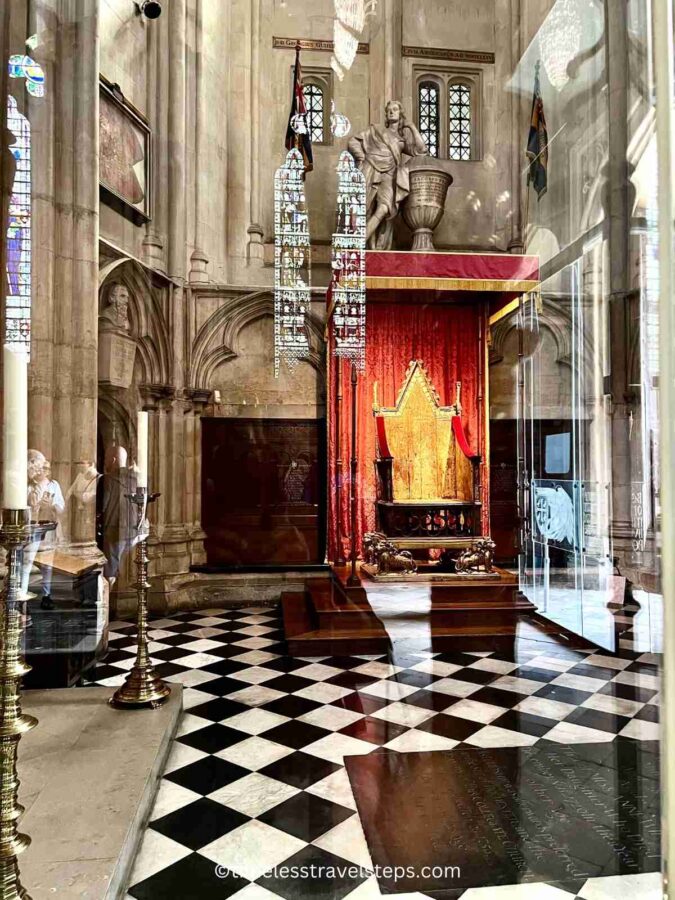
The Coronation Chair
As you move towards the Great West Door, which also serves as the exit, you will encounter the iconic Coronation Chair, encased in a glass cube, with further reinforced protection. This historic artefact has played a central role in the coronation of English and British monarchs since it was commissioned by King Edward I in 1296. It has been used in the coronation ceremonies of 39 English and British monarchs, including, most recently, the coronation of King Charles III.
Originally crafted to sit on the Stone of Scone—a symbol of Scottish kingship taken by Edward as a spoil of war—the chair represents the unification of England and Scotland under a single monarch. The Stone of Scone, also known as the Stone of Destiny, was returned to Scotland in 1996, but the Coronation Chair remains an enduring symbol of continuity and tradition.
During coronation, the chair is placed in front of the High Altar on the Cosmati Pavement, adding to its historical and spiritual significance.
The Nave and Renowned Graves
I was utterly captivated at this point in my visit to Westminster Abbey and Lady Chapel. The grandeur of the imposing Nave, that spans the length of the Abbey, is an architectural marvel and truly a jaw-dropping sight!
The Nave of Westminster Abbey is a breathtaking example of Gothic architecture, stretching impressively from the Great West Door to the choir screen. Its design features soaring, pointed arches supported by slender, intricately carved pillars that create a sense of verticality and lightness. The Nave’s vaulted ceiling is unique. Ribbed and complex, drawing the eye upwards and enhancing the sense of grandeur.
Natural light floods the Nave through large, ornate stained glass windows that line the upper walls. These windows, depict various biblical scenes and figures, illuminating the interior with colourful light and depth to the space.
You can easily miss what lies beneath these arches. Look down and you’ll notice the floor of the Nave is lined with memorials and graves, including those of notable figures such as Sir Isaac Newton, Charles Darwin, and Stephen Hawking, making it a place of significant historical importance.
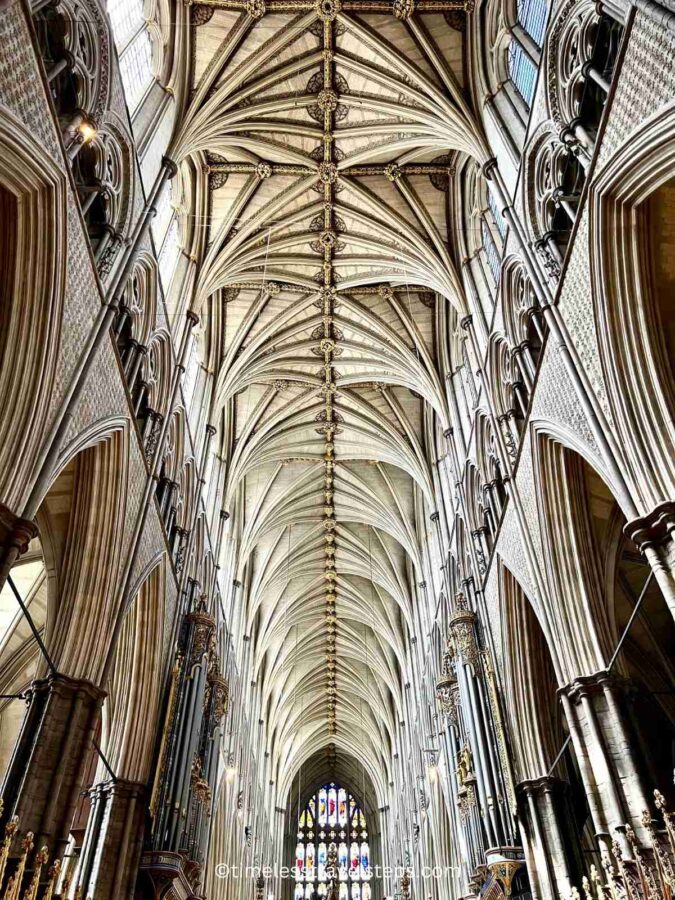
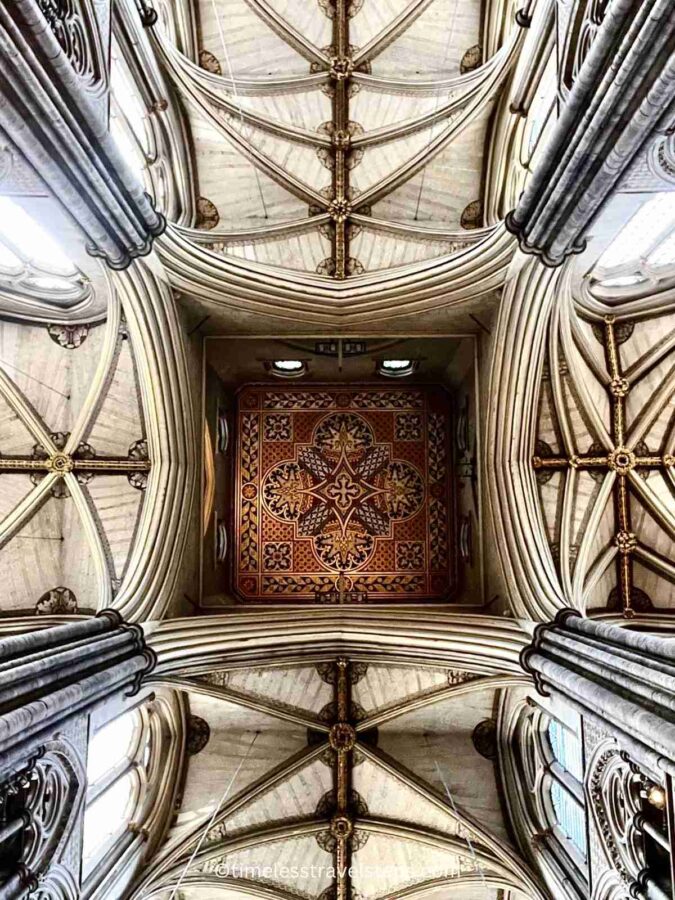
The Crossing in Westminster Abbey
The Crossing in Westminster Abbey is the central area where the Nave, transepts, and Quire intersect. When you are at this pivotal space, look up for a stunning fan-vaulted ceiling supported by massive stone pillars, exemplifying the Gothic architecture this Abbey is known for. This space serves as a hub for movement within the Abbey, connecting key areas and enhances the flow of processions and ceremonies.
The Choir Screen
The Choir Screen in Westminster Abbey is an ornate, intricately designed barrier that separates the Nave from the Quire. The screen features statues of ten monarchs, including those of King George V and Queen Mary, which were added in the 20th century by sculptor Sir William Goscombe John.
The Quire at Westminster Abbey
Step beyond the Choir Screen and visit the Quire. The Quire is a beautifully ornate section of Westminster Abbey where the choir performs during services, providing a captivating glimpse into the Abbey’s rich musical heritage. The Quire is adorned with intricately carved wooden stalls and elegant fittings, with specific seating plan as to who sits where.
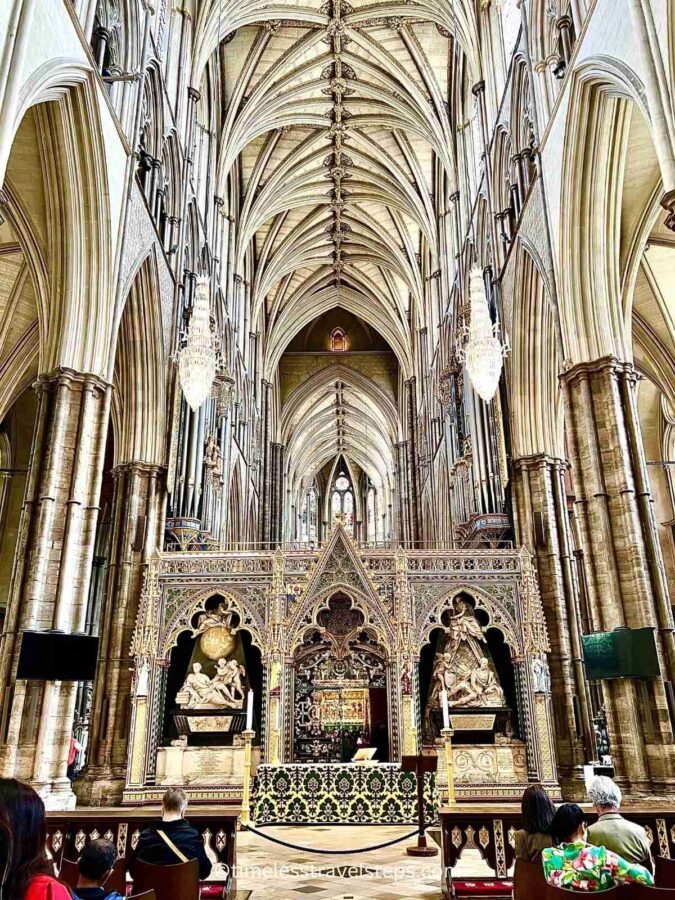
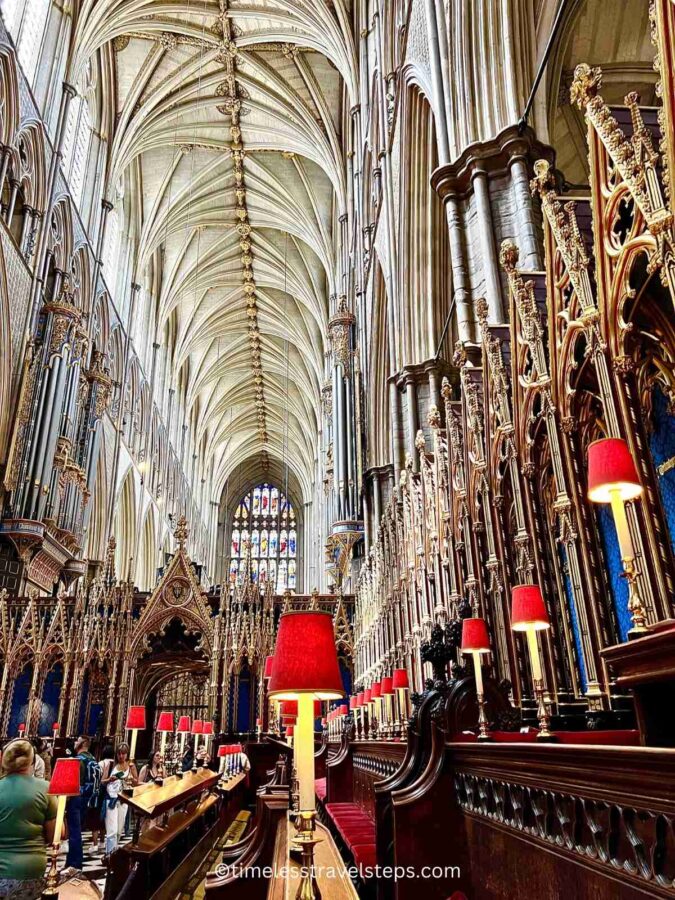
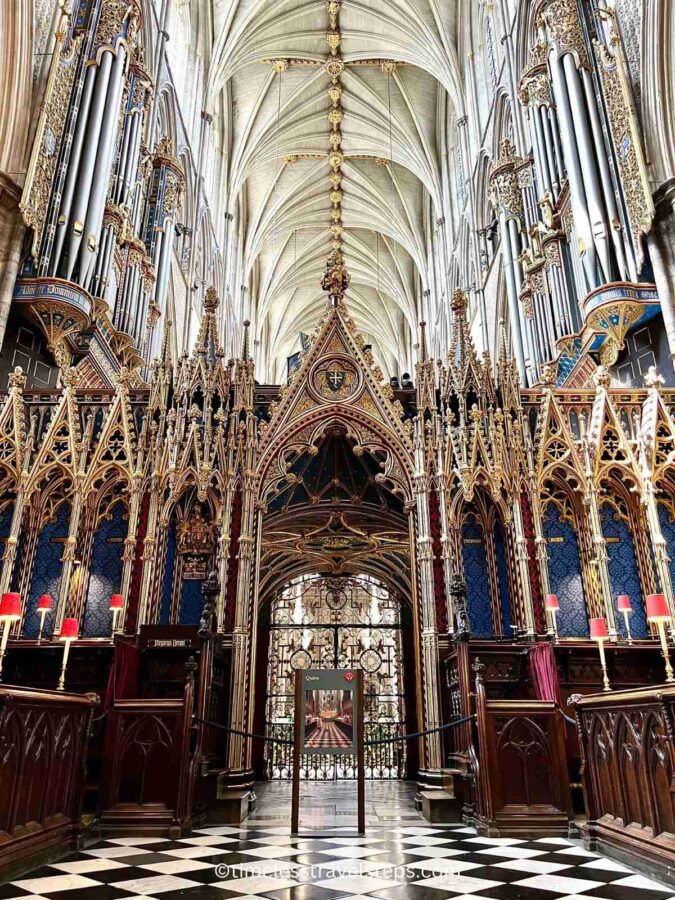
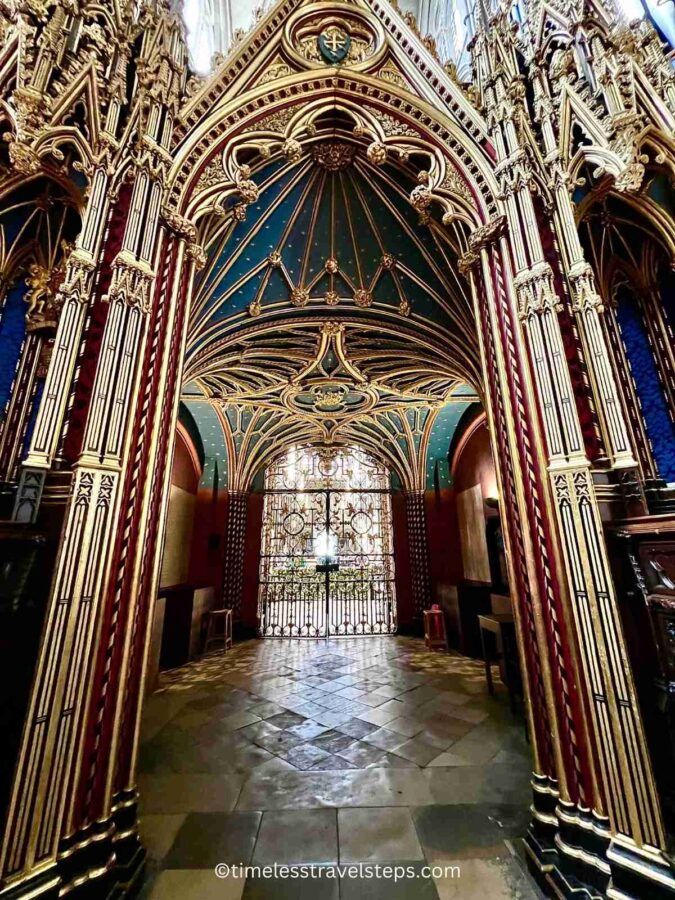
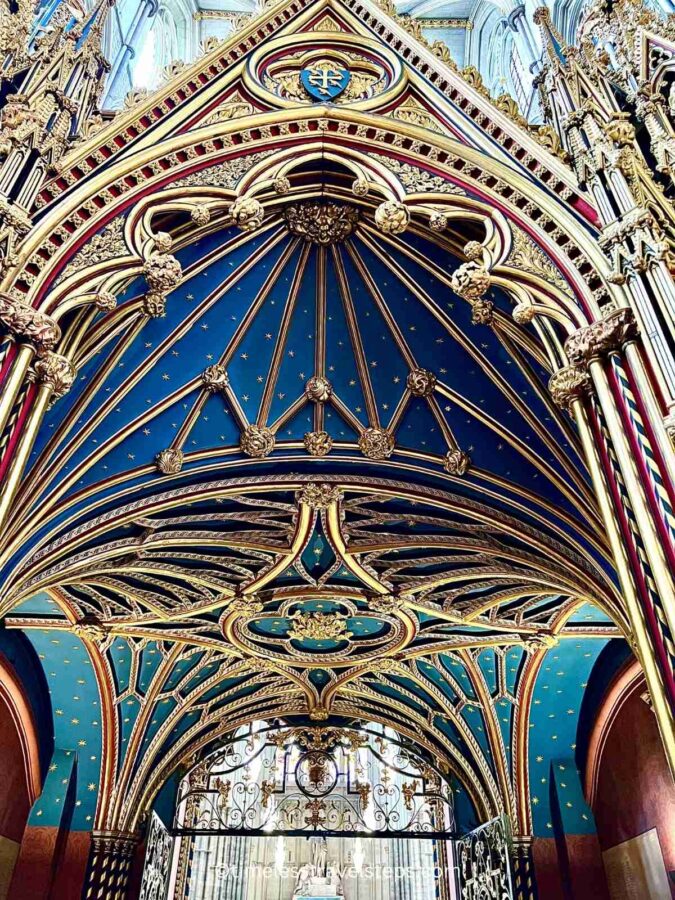
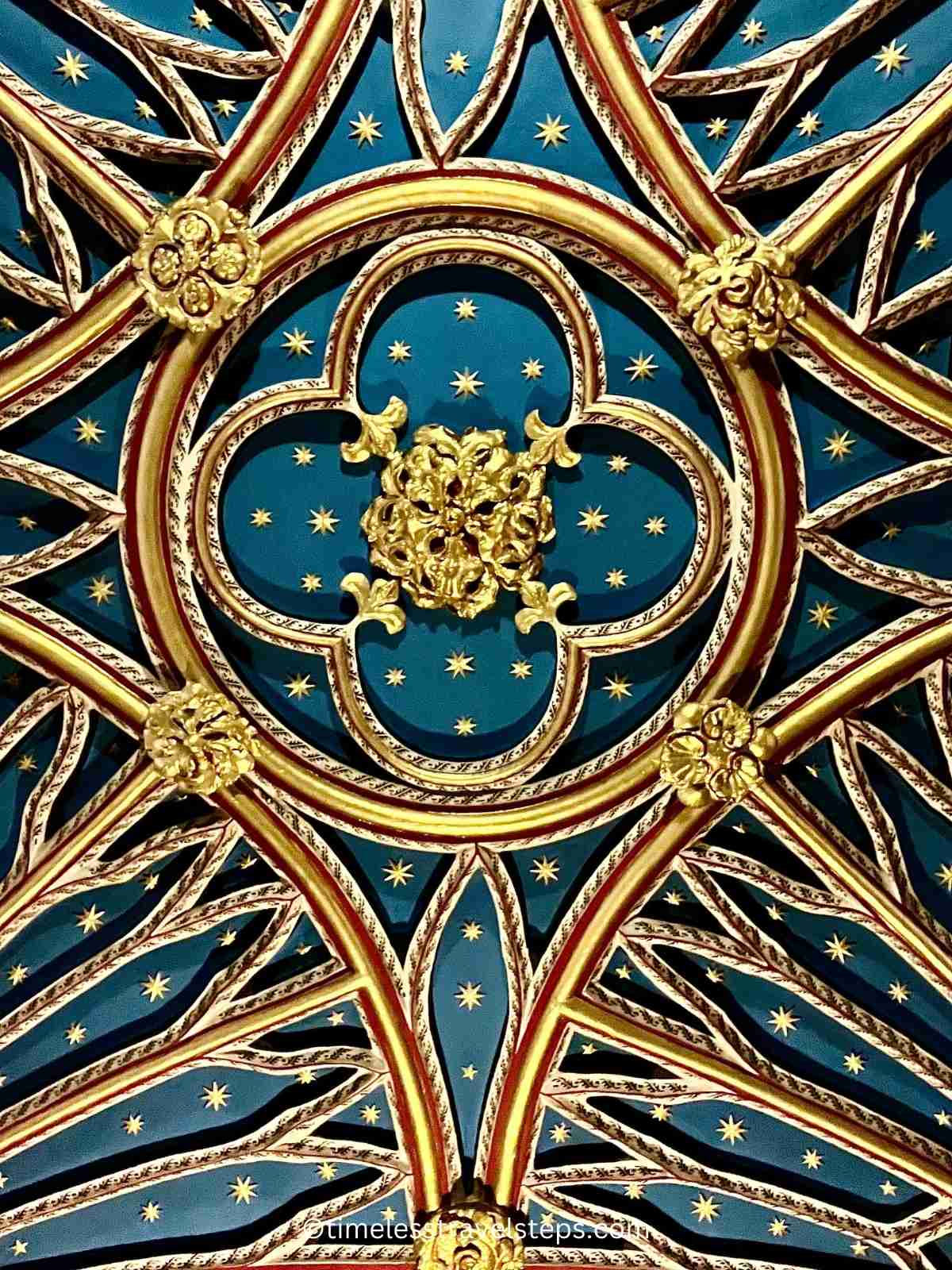
High Altar and Cosmati Pavement
Moving ahead from the Quire, you will find the High Altar, the spiritual focal point of the Abbey. The High Altar is distinguished by its ornate screen and the magnificent reredos behind it, which features intricate carvings and religious iconography. The altar is used for major religious ceremonies and is a key element of the Abbey’s religious life.
In front of the High Altar lies the Cosmati Pavement, a stunning mosaic floor from medieval times, commissioned by Henry III in 1268. This intricate flooring was created by a Roman craftsman. Composed of coloured glass, stone, and precious materials set into a framework of Purbeck marble, in a geometric pattern said to represent the universe.
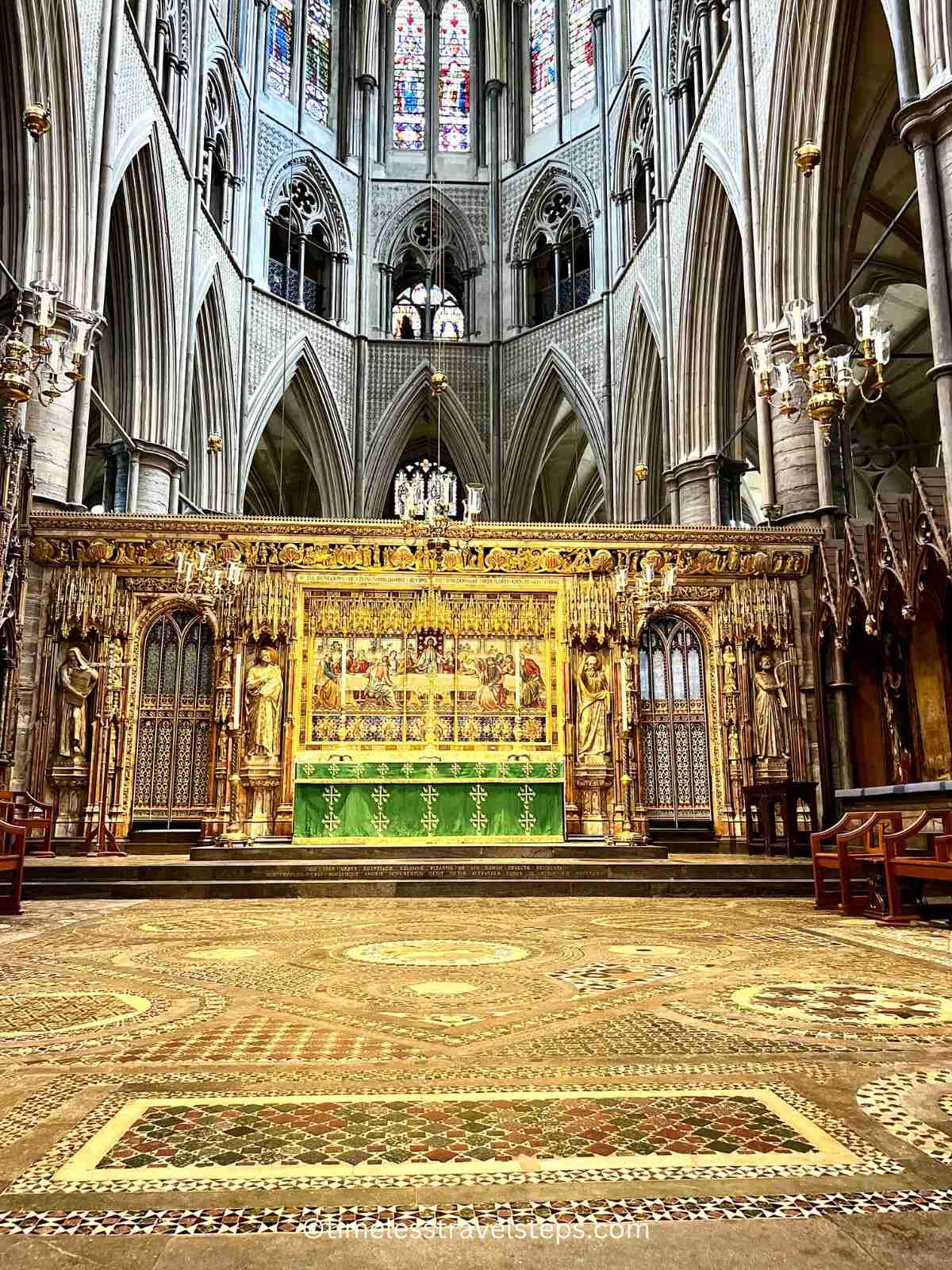
TIP: Follow the media or numbered guide from the High Altar, which will lead you towards your left, on a clockwise route. This path will take you past the Shrine of St. Edward the Confessor, one of the most sacred sites in the Abbey. Continuing on, you’ll encounter the tombs of Henry III and Henry V, each reflecting their historical significance and royal heritage. The route then guides you to the tombs of Elizabeth I and Mary I, where you can reflect on these two monarchs’ fascinating and turbulent history.
Edward the Confessor’s Chapel
St. Edward the Confessor’s Chapel, is a sacred and historically significant part of the Abbey. The chapel was built to house the remains of King Edward the Confessor, who reigned from 1042 to 1066 and was canonized as a saint in 1161 due to his deep religious devotion and piety.
His shrine, an elaborate structure made of Purbeck marble, is surrounded by steps to allow pilgrims to approach closely, but this area is sometimes closed off during peak times. Edward’s reign marked the end of the Anglo-Saxon era, and his death without an heir led to the succession crisis and the Norman Conquest.
The Henry VII Lady Chapel at Westminster Abbey
The Lady Chapel, also known as the Henry VII Chapel, is situated at the far east end of Westminster Abbey, beyond the High Altar and the Sanctuary, aligning with traditional designs, where the most sacred parts of the church are positioned at its easternmost point.
The Lady Chapel at Westminster Abbey was built between 1503 and 1516 by King Henry VII. It was designed by the architect Sir Reginald Bray. The chapel is dedicated to the Virgin Mary and serves as the burial site for notable figures. There are about 15 tombs in the Chapel including Henry VII, Elizabeth of York, Mary, Queen of Scots and, Elizabeth I.
As you ascend the steps flanked by the standards of the Knights of the Order of the Bath, the grandeur of the chapel immediately unfolds before you. With the banners of the knights above you, bright and airy, the intricate fan-vaulted ceiling, the chapel, elaborate tombs, and stunning stained glass windows create a breathtaking first impression, adding a somewhat ceremonial element to your visit. It’s like a hidden gem within the wider splendour of the Abbey. A truly magnificent setting, one that is worth experiencing. Here are some of the important tombs not to miss:
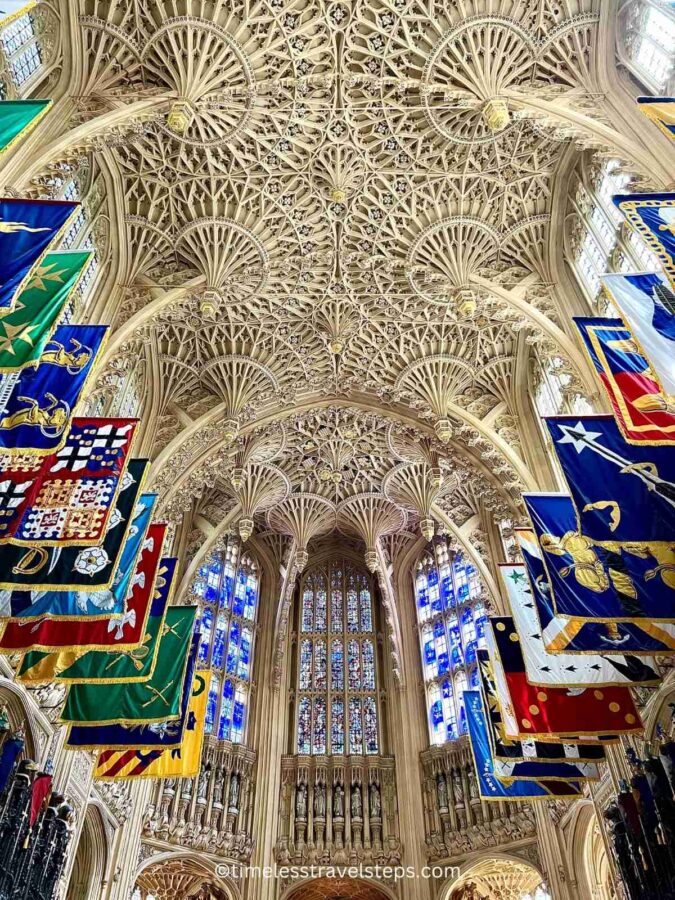
The Tombs of Elizabeth I and Mary I in the North Aisle of the Lady Chapel
As you head clockwise as per the guide, you’ll be guided to the left side of the Lady Chapel. It is a serene and dignified space, featuring intricate Gothic architecture and decorative elements.
The tomb of Elizabeth I is an elaborate monument with a white marble effigy of the queen lying in state. The effigy is adorned with her royal insignia, including a scepter and an orb, symbolizing her authority and sovereignty. The orb is adorned with the Tudor rose, representing her father’s House of Tudor, while the scepter bears the symbols associated with her mother, Anne Boleyn. The tomb is richly decorated emphasizing her legacy as one of England’s most significant monarchs.
Mary I’s tomb is less ornate than that of Elizabeth I, but it is equally significant. The two tombs are positioned side by side, symbolizing their connection and the complex history between them.
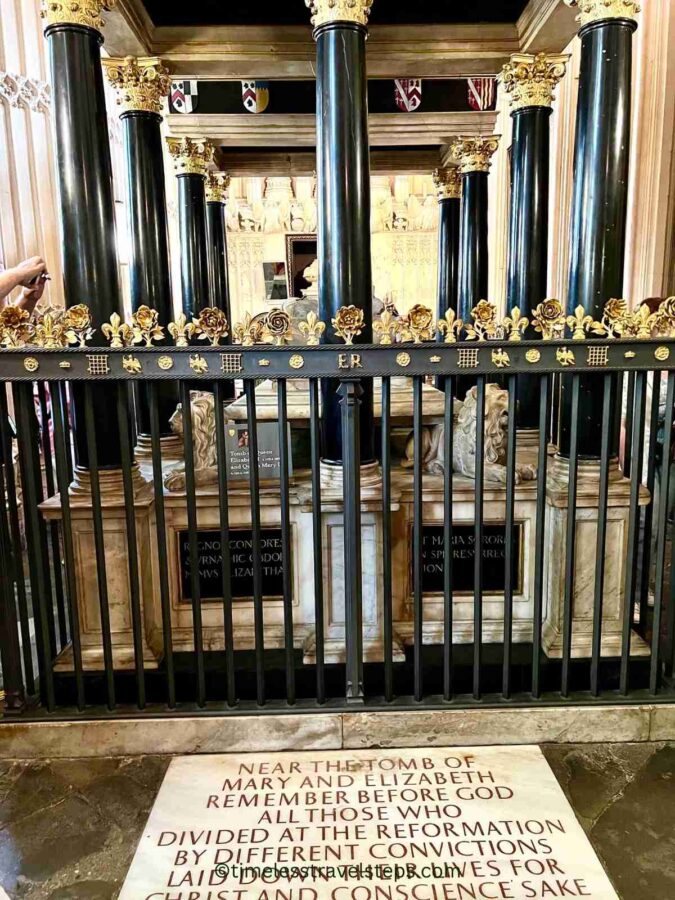
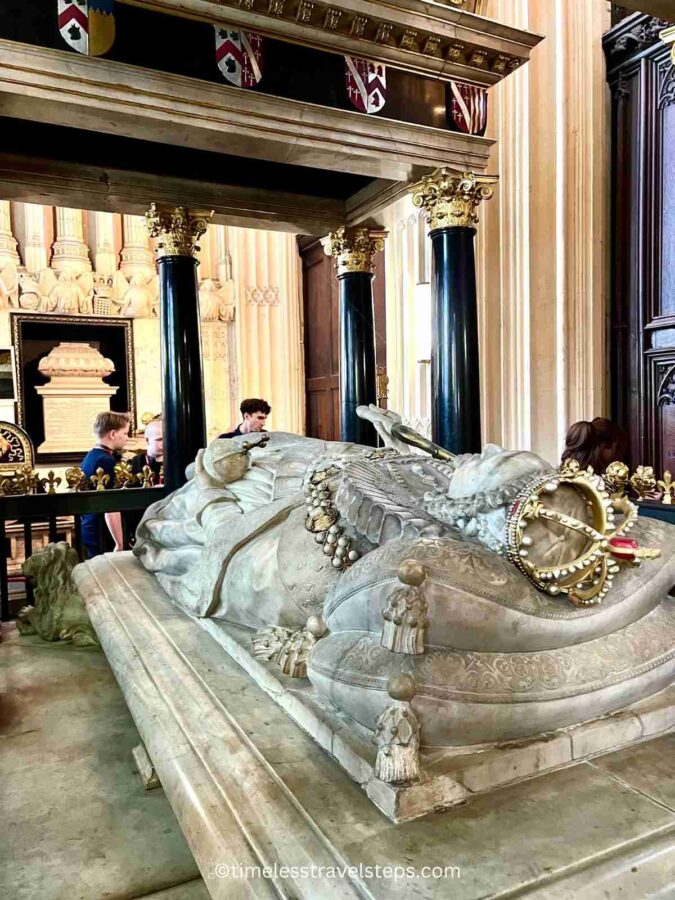
About Mary I and Elizabeth I
Elizabeth I and Mary I were half-sisters, both daughters of Henry VIII, but they had different mothers—Anne Boleyn and Catherine of Aragon, respectively. Elizabeth I and Mary I were not particularly close growing up. Despite their strained relationship in life, were united in death, as their tombs lie side by side in the North Aisle of the Lady Chapel at Westminster Abbey.
Mary I ruled England and Ireland from 1553 to 1558, but she did not rule over Scotland, so she did not rule Britain in its entirety. Her reign is particularly noted for her attempts to restore Roman Catholicism in England, earning her the nickname “Bloody Mary” due to the persecution of Protestants.
The Sword of King George VI
The sword, encased in protected glass at the entrance of the Lady Chapel in Westminster Abbey is the Sword of King George VI. It was presented to the Abbey by Queen Elizabeth II in 1952 in memory of her father, King George VI. The sword is displayed as a symbol of bravery and service, particularly honouring the role of the Royal Air Force during World War II.
Oliver Cromwell at The Lady Chapel
On the floor, in front of the altar of the Lady Chapel at Westminster Abbey, lies a plaque dedicated to Oliver Cromwell. Cromwell, a key figure in the English Civil War and the subsequent establishment of the Commonwealth, was initially buried with great honour in the Abbey following his death in 1658.
However, after the Restoration of the monarchy in 1660, Cromwell’s body was exhumed and subjected to posthumous execution. The plaque marks the location of his original burial site.
After his body was exhumed and subjected to a posthumous execution in 1661, Oliver Cromwell’s remains were buried in an unmarked grave at Tyburn, near present-day Marble Arch in London. His head was placed on a spike above Westminster Hall, where it remained for many years before eventually being buried in the grounds of Sidney Sussex College, Cambridge.
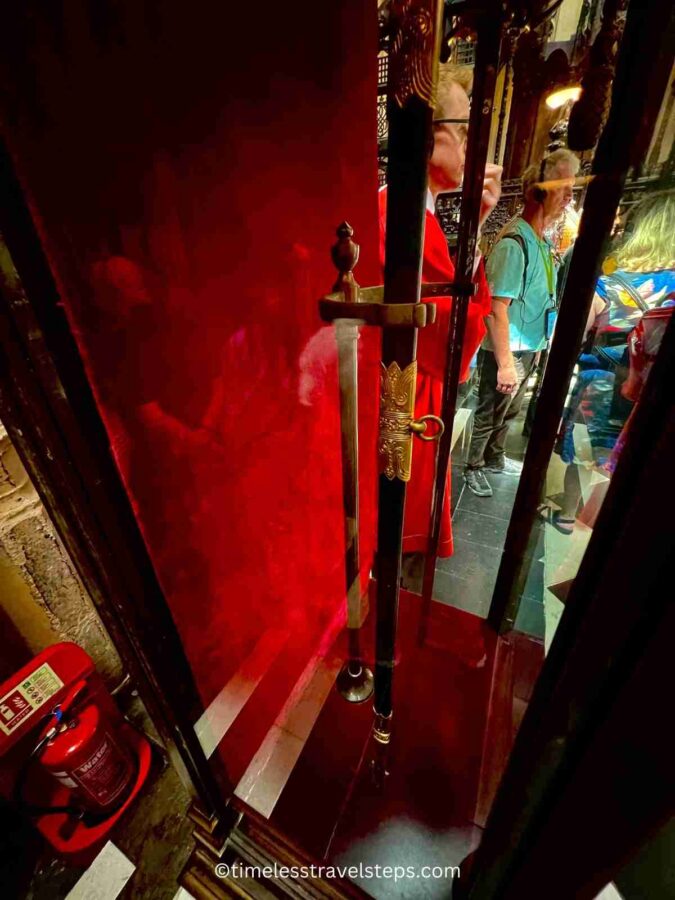
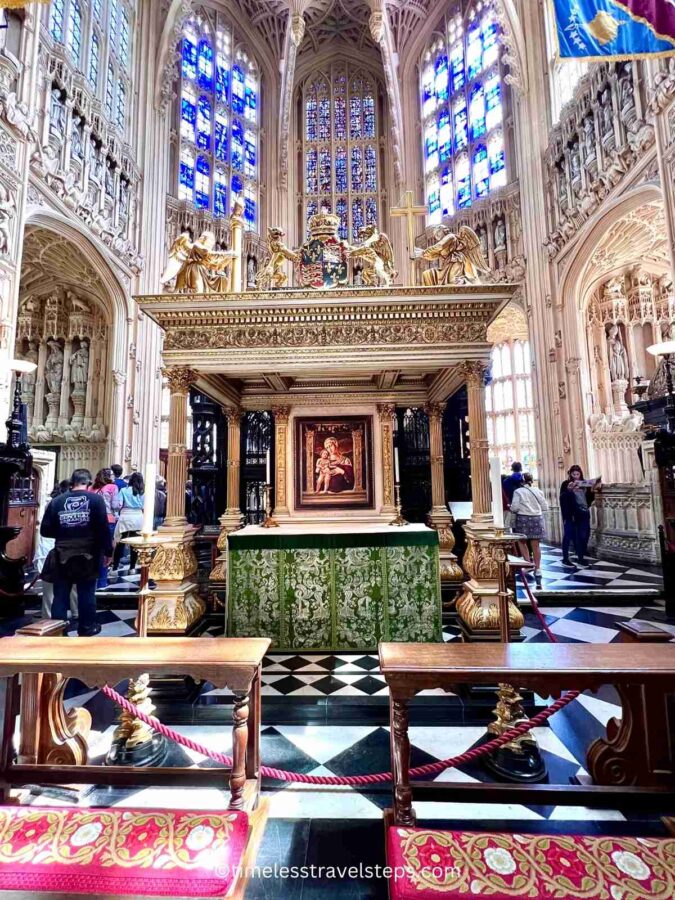
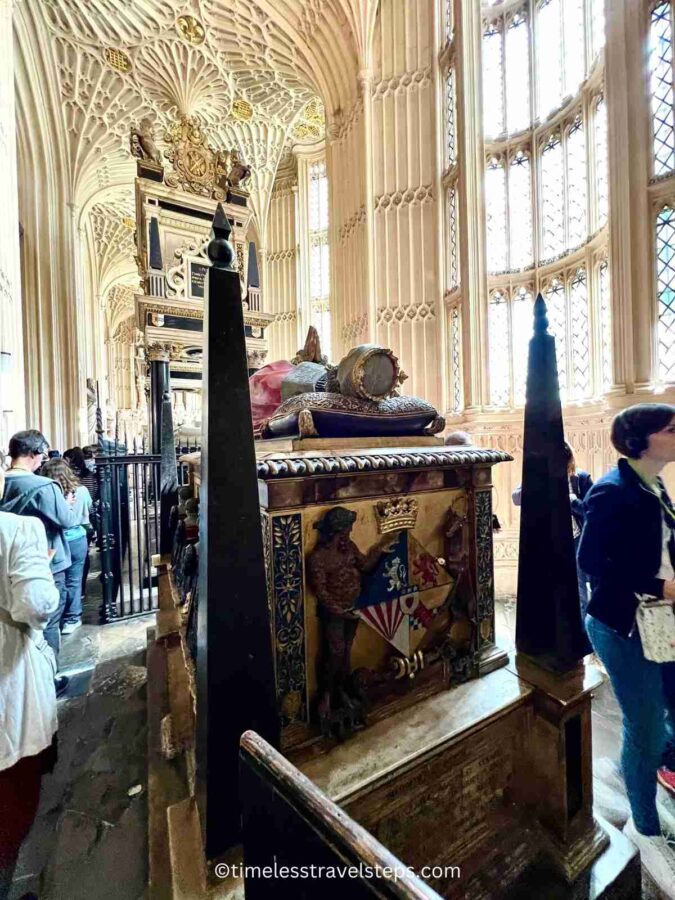
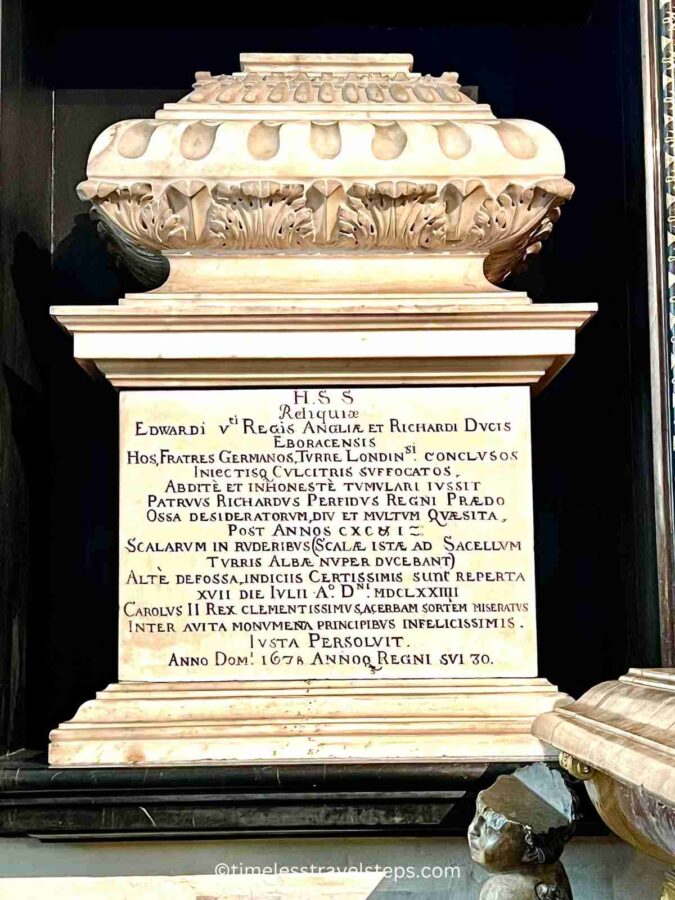
Mary, Queen of Scots at The Lady Chapel
Mary, Queen of Scots, ruled Scotland from 1542 to 1567 and was a significant historical figure whose life was marked by political and personal challenges. Seeking refuge in England, she was imprisoned by her cousin, Queen Elizabeth I, for 19 years. In 1587, Mary was executed for her alleged involvement in plots to assassinate Elizabeth and claim the English throne.
Initially buried at Peterborough Cathedral, her remains were exhumed in 1612 by her son, King James I of England (James VI of Scotland), and reinterred in the Lady Chapel at Westminster Abbey.
Mary’s tomb in the Lady Chapel is an elaborate structure. You’ll find her tomb slightly raised compared to the others. James I wanted it this way to underscore her royal lineage and the high regard in which he held his mother.
Tombs of Kings and Queens
Alongside Mary, Queen of Scots, you’ll find the following prominents tombs also:
The tombs of Henry VII and Elizabeth of York, the founders of the Tudor dynasty, are buried in a magnificent central tomb.
Margaret Beaufort, Mother of Henry VII and a key figure in establishing the Tudor dynasty, is also in this room, next to his son.
James I (James VI of Scotland), Son of Mary, Queen of Scots, is buried near his mother’s tomb. Anne of Denmark, the wife of James I, also laid to rest next to him.
At the far end of the room, there are two notable tombs:
The tomb of Edward VI, the only legitimate son of Henry VIII, who reigned from 1547 to 1553. His tomb is relatively modest compared to those of other monarchs.
The tomb of Margaret Douglas, Countess of Lennox, who was the daughter of Margaret Tudor (Henry VIII’s sister) and mother of Henry Stuart, Lord Darnley, who was the husband of Mary, Queen of Scots and father of James I (James VI of Scotland).
Innocents’ Corner
Innocents’ Corner in Westminster Abbey is a poignant space dedicated to the memory of children who have passed away. Here, you’ll find a shrine for the bones found in the Tower of London. These bones are believed to be those of the young “Princes in the Tower,” Prince Edward V and his younger brother Richard, Duke of York, sons of King Edward IV, who disappeared in 1483.
Their remains were discovered in 1674 during construction at the Tower and re-examined in 1933 before being interred in Westminster Abbey. The mysterious disappearance and presumed murder of the princes remain subjects of historical intrigue.
Royal Air Force Chapel
The Royal Air Force Chapel is located within Lady Chapel in Westminster Abbey. It commemorates those who served and died in the Royal Air Force during World War II. The chapel features stained glass windows depicting scenes from the Battle of Britain and other significant moments in RAF history.
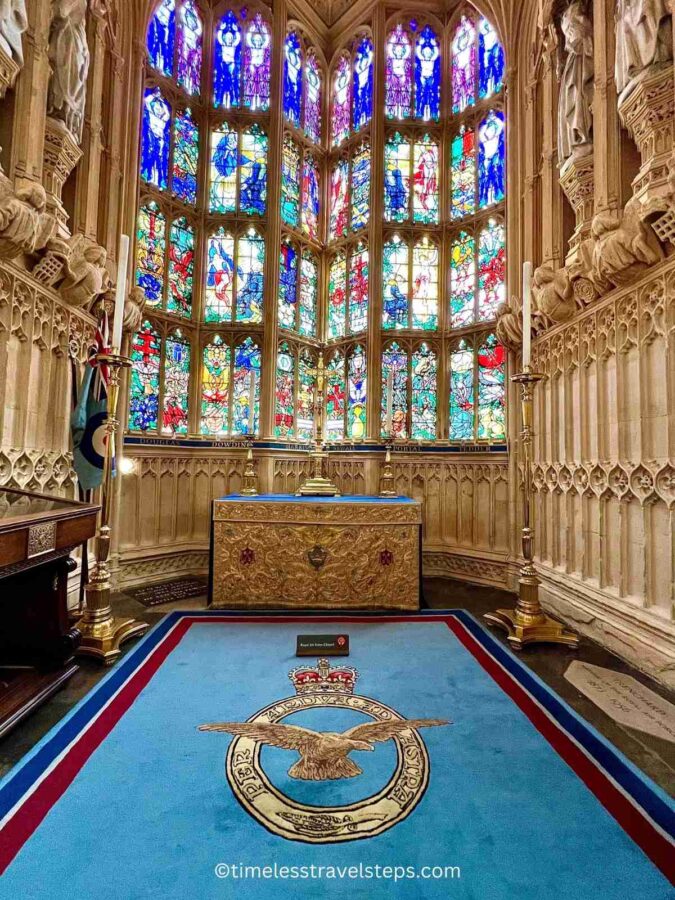
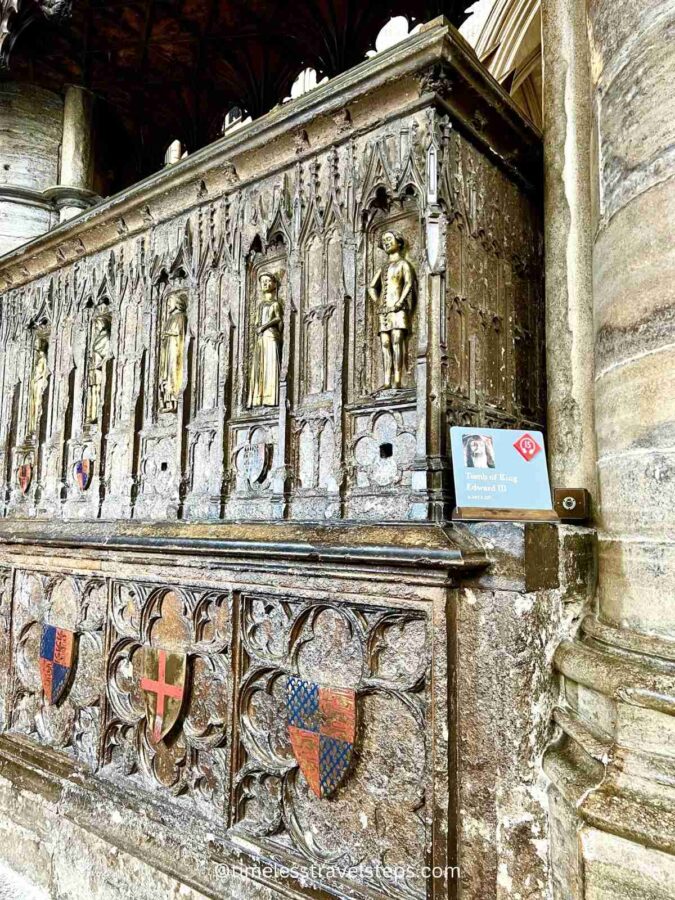
The Poet’s Corner
From the Lady Chapel, head towards the Poet’s Corner. This space, located in the South Transept of Westminster Abbey, is renowned as the burial and memorial site for many of Britain’s most distinguished literary figures. It began with the burial of Geoffrey Chaucer in 1400 and expanded to include other notable writers such as Edmund Spenser, Ben Jonson, and Charles Dickens. Memorials honour those buried elsewhere, like William Shakespeare and Jane Austen.
This is an area where you can spend some time locating your favourite authors, such as Lord Byron or T.S. Eliot. This area also offers access to the Jubilee Galleries.
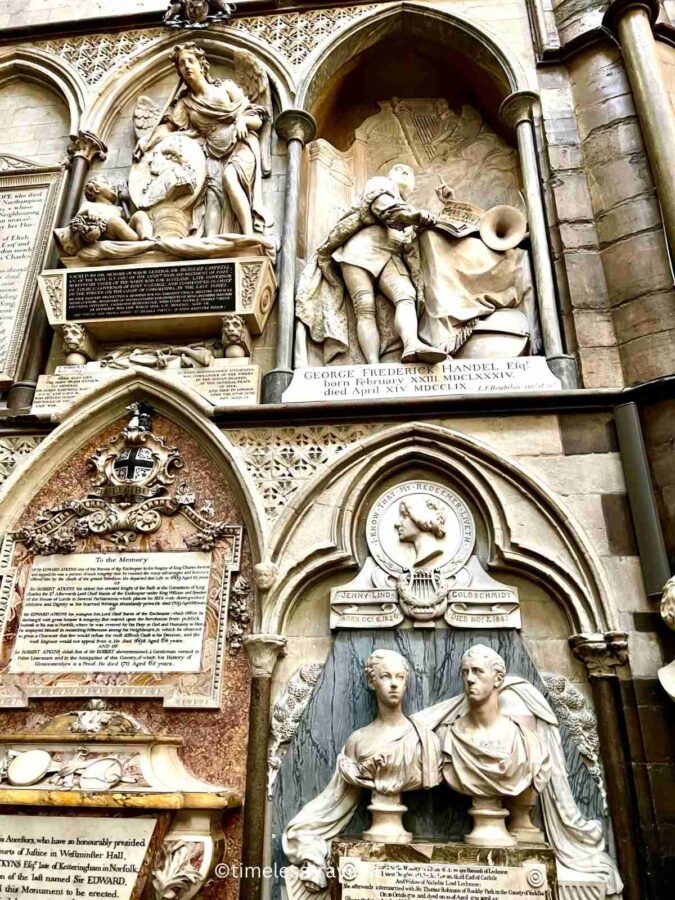
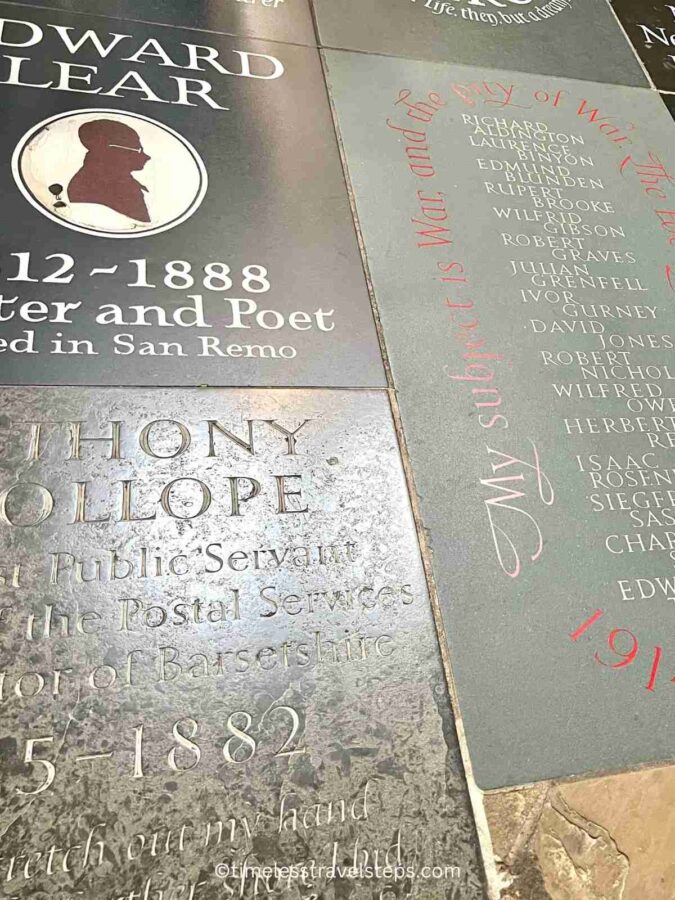
Queen’s Diamond Jubilee Galleries
The Queen’s Diamond Jubilee Galleries, located high above the Abbey floor in the eastern triforium of Westminster Abbey, were opened to the public for the first time in June 2018. Access to the Queen’s Diamond Jubilee Galleries is either by a staircase of 108 steps or by elevator, making it accessible to most visitors.
Once at the top, you are rewarded with a jaw-dropping view of the entire length of the Abbey’s Nave, looking down from about 70 feet above, and get a unique view of the Cosmati Pavement and the High Altar. The vantage point also provides spectacular views of nearby landmarks such as the Palace of Westminster and Big Ben through the Abbey’s ancient windows.
The space itself is a marvel of medieval architecture, with its original 13th-century vaulted ceilings and stonework carefully restored and preserved.
Highlights of the Queen’s Diamond Jubilee Galleries’ Exhibits
Strictly no photography allowed here, but here are some of the highlights in the exhibition:
1. One of the most significant artefacts on display is the Coronation Chair of Queen Mary II. This chair was specially made for her coronation alongside her husband, William III, in 1689. It is a rare and fascinating piece of history, providing insight into the coronation traditions of the time.
2. Dating back to the late 14th century, the Litlyngton Missal is an illuminated manuscript that was used in the daily services of the Abbey. It is named after Abbot Nicholas Litlyngton, who commissioned it, and is renowned for its beautiful illustrations and detailed craftsmanship.
3. The Galleries house several important Anglo-Saxon charters, including the original charter of King Offa of Mercia, dating from the 8th century. These documents are crucial to understanding the early history of the Abbey and the region.
4. One of the oldest surviving altarpieces in England, the Westminster Retable, dating from around 1260, is displayed in the Galleries. It features intricate carvings and paintings depicting scenes from the life of Christ, showcasing the exceptional artistic skills of medieval craftsmen.
5. The collection includes various rare texts and manuscripts, providing a deep dive into the Abbey’s literary and historical archives.
6. Other exhibits include the Marriage Licence of Prince William and Catherine Middleton; funeral effigy of Horatio Nelson (buried in St Paul’s Cathedral), a Lady in a Wimple, and display cases which you can open to explore.
Beyond Westminster Abbey and The Lady Chapel: The Cloisters, Chapter House, Pyx Chamber, St Katherine’s Chapel, and College Garden
After exploring the main areas of Westminster Abbey and the magnificent Henry VII Lady Chapel, there are several other notable sections within the Abbey grounds that are worth exploring. These include the Cloisters, the Chapter House, the Pyx Chamber, St. Katherine’s Chapel, and College Garden.
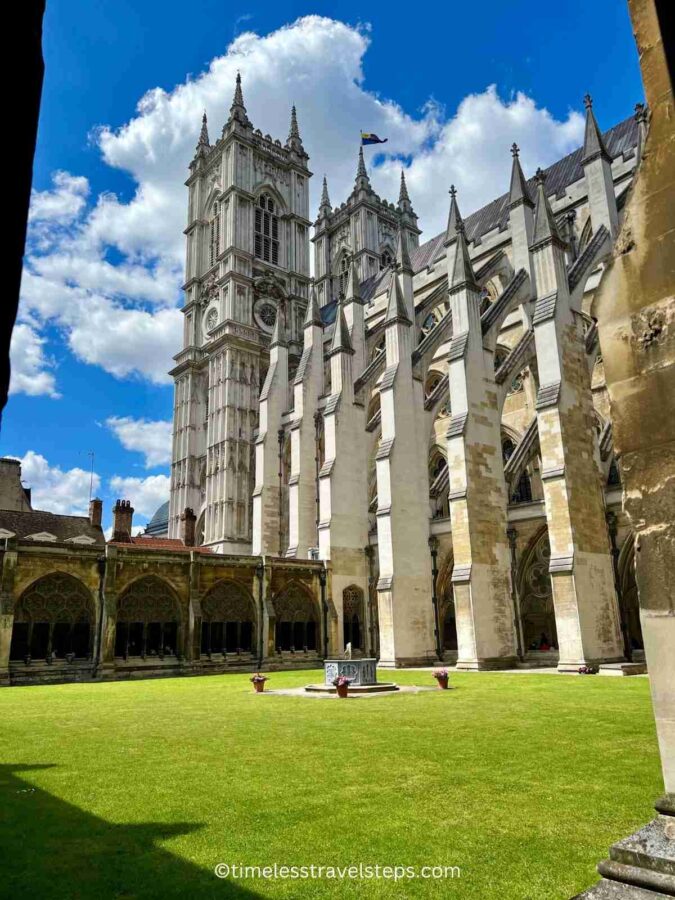
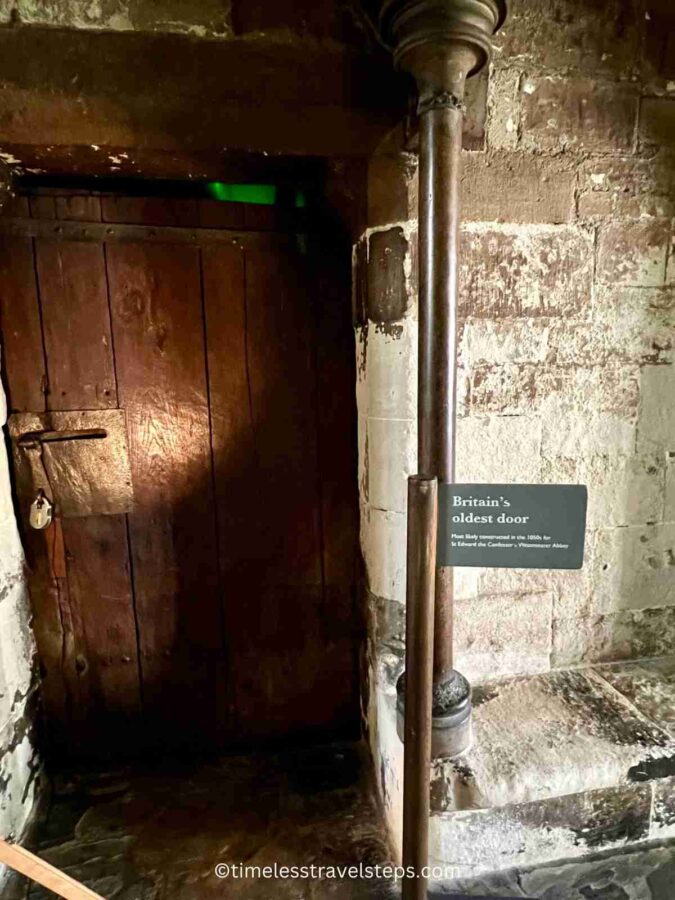
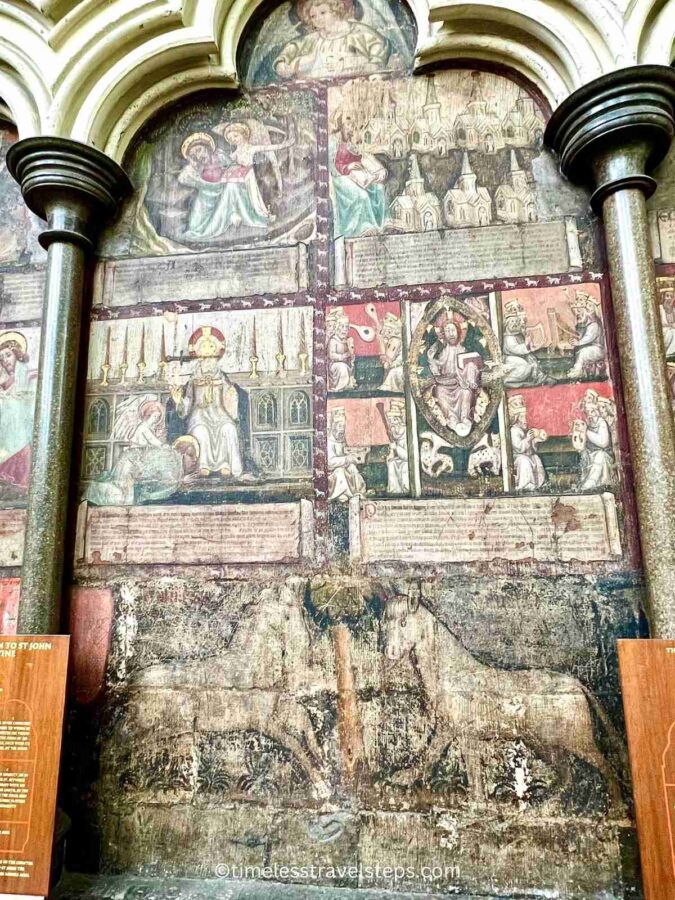
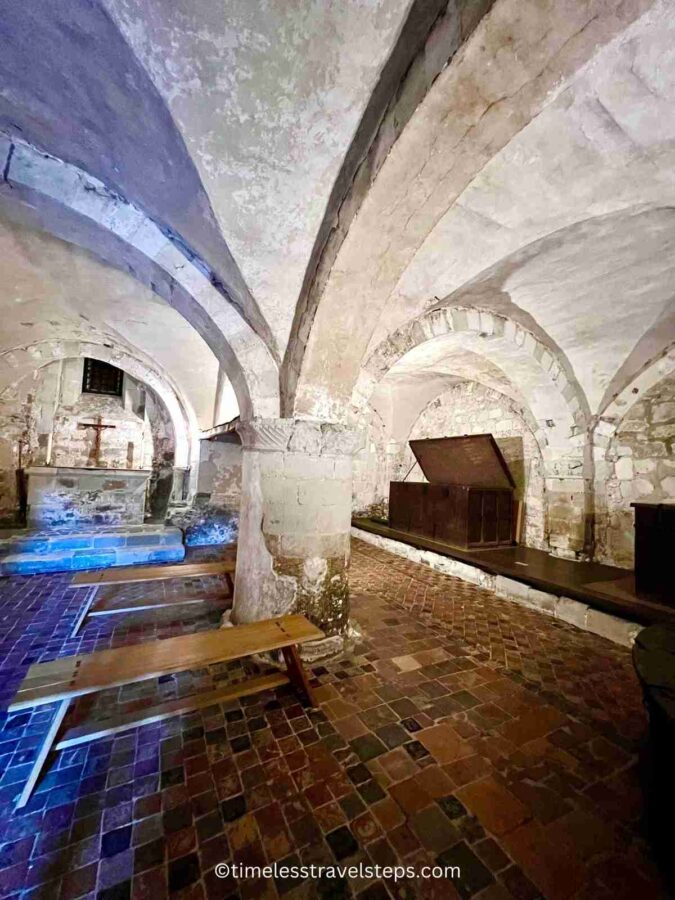
The Cloisters
The Cloisters are a quadrangular covered walkway that encloses a central courtyard, historically used by the monks of Westminster Abbey for meditation and exercise. Today, the Cloisters provide a serene atmosphere featuring Gothic arches and vaulted ceilings, along with places to sit. Tombs of significant historical figures are located along the Cloisters, offering a walk through history.
The Chapter House
The Chapter House is a quiet delight! One of the oldest and most architecturally impressive parts of Westminster Abbey, the Chapter House was built in the 13th century and served as a meeting place for the monks. It was here that the early parliaments of England gathered. The room is octagonal, features stunning stained glass windows and a beautifully decorated ceiling with a central column branching out like a palm tree.
What I really enjoyed discovering at the Chapter House was the Wall Paintings. The Chapter House walls are adorned with 14th century medieval paintings that depict biblical scenes. Though hazy and faded with age, still conveys a rich artistic heritage.
The Oldest Door in Britain
The oldest door in Britain is located in Westminster Abbey. This significant historical artefact is situated in the corridor leading to the Chapter House. This ancient door, dating back to early medieval around 1050, is made of oak and is believed to be the oldest still in use in the country.
The Pyx Chamber
The Pyx Chamber, dating back to around 1070, is one of the oldest surviving parts of Westminster Abbey. It was originally used as a treasury and later as a sacristy. It housed the Pyx, the box used to store the king’s gold and silver, which was used in coinage trials.
The chamber is characterized by its thick stone walls and sturdy oak doors from the 14th century, highlighting the medieval architecture and security measures of the time.
St. Katherine’s Chapel
St. Katherine’s Chapel, also known as the Little Cloister, has a history dating back to the medieval period, and offers a tranquil and reflective space within the Abbey grounds.
College Garden
One of the oldest gardens in England, dates back over 900 years and was originally used by the Benedictine monks of Westminster Abbey. The monks cultivated medicinal herbs and food plants here. Today, College Garden is a beautiful and peaceful green space that features a variety of plants, flowers, and trees, making it a delightful spot for nature lovers.
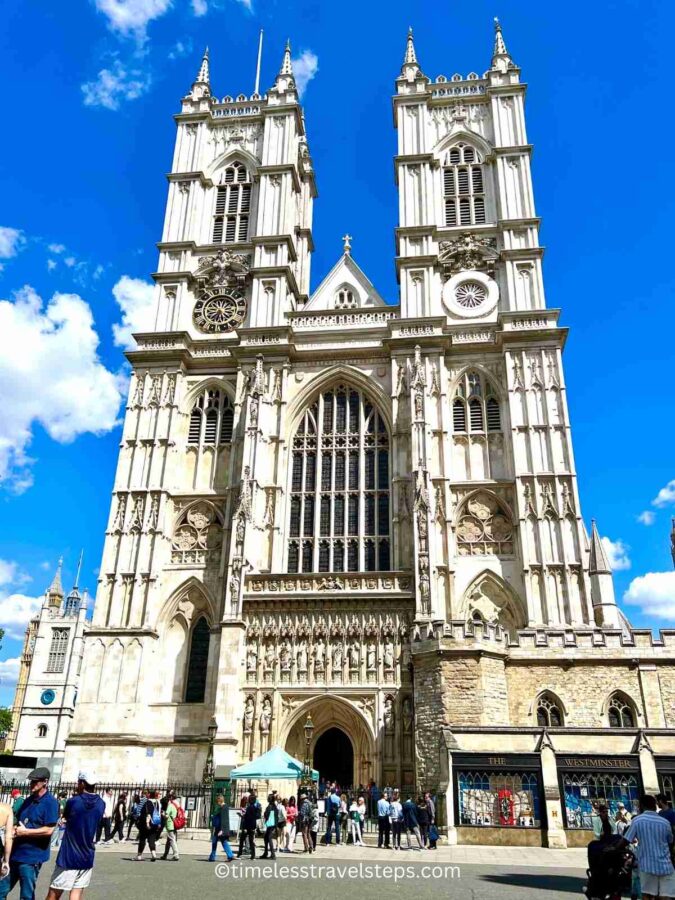
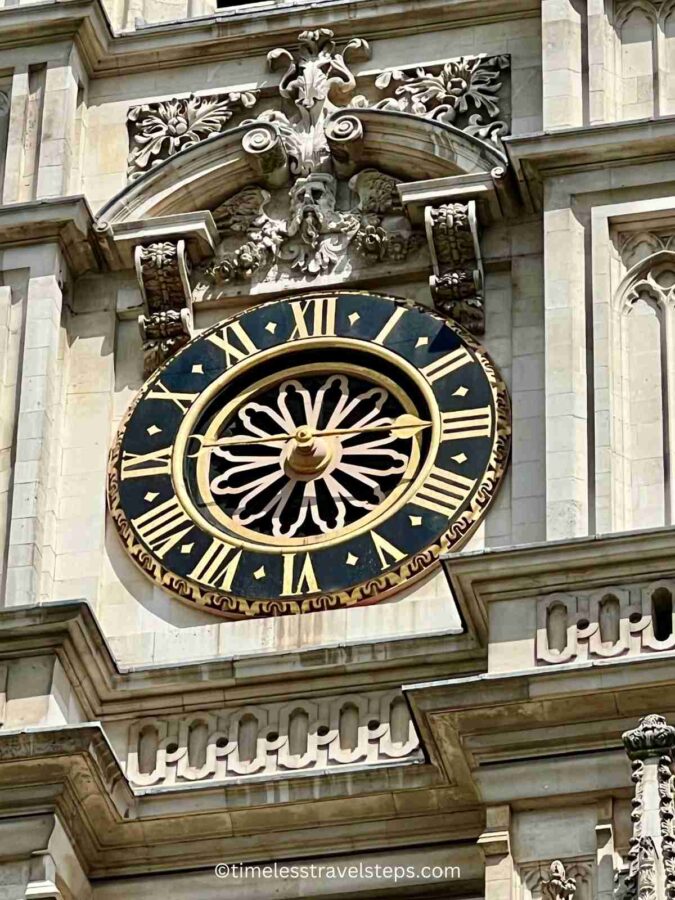
The Exterior and West Towers at Westminster Abbey
The Exterior of Westminster Abbey is highlighted by its magnificent Gothic Revival West Towers, completed in the mid-18th century. Some highlights to look out for:
Above the Great West Door of Westminster Abbey, you’ll find ten statues of 20th-century Christian martyrs. These include notable figures such as Martin Luther King Jr., Oscar Romero, and Dietrich Bonhoeffer, who were chosen to represent various denominations and parts of the world. These statues were unveiled in 1998 and serve as a powerful reminder of the sacrifices made for faith and justice.
The Clock at Westminster Abbey is situated above the North Transept. Installed in 1738 by clockmaker John Seddon, it features a single large hand to mark the hours, following the traditional clock design of the period.
The two Western Towers of Westminster Abbey were completed in the mid-18th century by Nicholas Hawksmoor, a pupil of Sir Christopher Wren. These Gothic Revival towers, made from Portland stone, add a majestic touch to the Abbey’s facade and house the Abbey’s ten bells, which are rung on various ceremonial occasions.
In sum…
Westminster Abbey and the Henry VII Lady Chapel are truly remarkable sites, and I hope this guide has given you all the information you are looking for. To ensure you make the most of your visit, remember to book your tickets in advance online. Not only does this help you avoid long queues, but it also guarantees entry, as the Abbey can be very busy, and tickets may not be available on the day, especially during peak tourist seasons.
For those looking to save on admission costs, consider purchasing the London Pass, which includes entry to Westminster Abbey along with many other top attractions in the city. Various other bundles and discount options may be available, so be sure to explore all your choices to find the best deal.
Before you go, take a look at some of the following most read posts about London:
Free Things to do near Chancery Lane, London.
Off-Beat, Free, & Ticketed Things to do in Greenwich, London + Tips.
Famous Food in London: Best Classic British Dishes you Must Try.
The Serenity of St Dunstan-in-the-Fields, London.
For all articles about London, head to Charming City London.
Happy and Safe Travels Always, Wherever Travel Takes You, xx
For more travel insights and tips, consider following Georgina on Instagram and Facebook. Don’t miss out on her latest adventures and expert advice. Subscribe to stay updated and join a community of fellow travel enthusiasts eager to explore the world through Georgina’s eyes.



